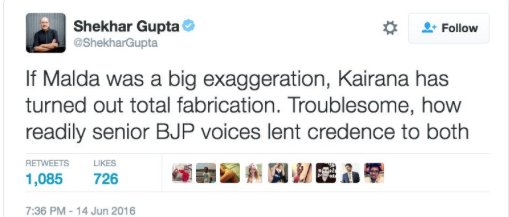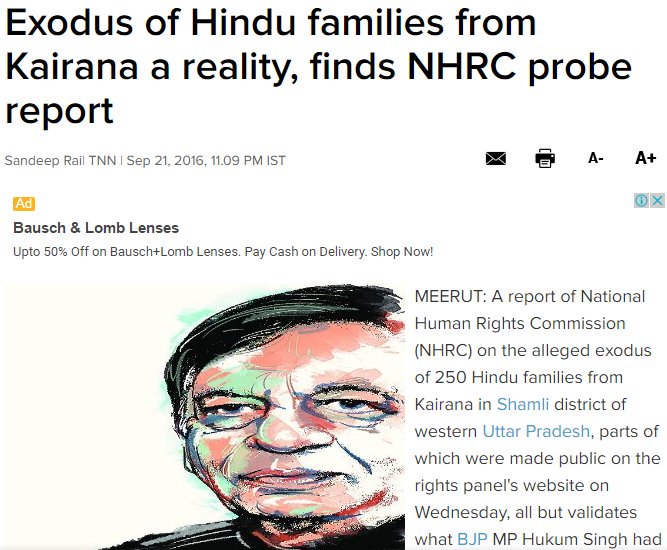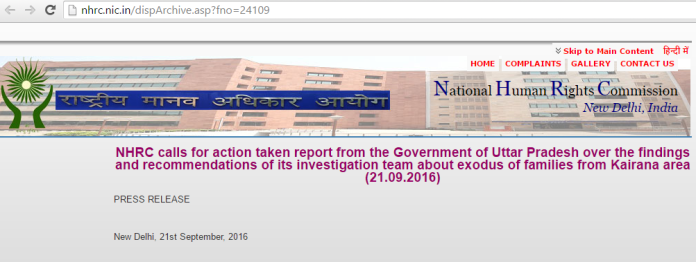Earlier in the summer of this year, a renowned writer of military-themed fiction tweeted thus:

So true. Someone has to stop people from making exaggerated claims like Malda once being a part of India. And someone really needs to stop crazy Hindu males from making claims about the existence of some fabricated place called “Kairana”, where Hindu families used to be allowed to stay.
Oh wait, those things will be tweeted by the Shekhar Guptas of a future generation, perhaps 50 years from now.
For now, this Shekhar Gupta is saying that nothing happened in Uttar Pradesh’s Kairana. Hopefully, that villager type BJP MP called Hukum Singh has learned a valuable lesson about the importance of verifying facts, preferably by studying the standards set by The Indian Express.
So, imagine my surprise when I saw this story yesterday.

Now since I do not happen to be a published author with information about secret movements of Indian Army units, I felt it was necessary to verify what has really been said and what hasn’t. This journey took me to the website of the National Human Rights Commission (NHRC), where I found this report:

(http://nhrc.nic.in/dispArchive.asp?fno=24109)
Let’s the NHRC explain in its own words what triggered their enquiry:
“The Commission received a complaint from Miss Monika Arora, Advocate, Supreme Court of India and convener of an NGO stating that families of a particular religion are leaving Kairana area of Western UP due to fear of criminals. It had been alleged that a woman belonging to Kashyap caste was abducted, gang-raped and killed, yet no action was taken by the police against the offenders.”
I am getting ready to read about how “senior BJP voices” lent credence to all this kind of “complete fabrication”, aren’t you? Let’s keep reading the NHRC release:
“It was found to be correct that the victim Smt. Guddi @ Surendri (Kashyap family), as mentioned in the complaint, was kidnapped on 4.4.2016 and was subsequently murdered by Kurban, Mohsin and others.”
Wait, what? How can that be? Doesn’t the NHRC know that senior media voices have already lent credence to the fabrication theory? Oh and for the sake of Indian secularism, I do hope that the real name of Mr Kurban is Krishna and the real name of Mr Mohsin is Mahesh.
What else is in the report?
“The matter was reported to the police of PS Kairana on 5/4/2016 by Sh. Sangat, husband of the victim Smt. Guddi @ Surendri, but the police neither registered an FIR in this regard nor started to search for Smt. Guddi @ Surendri the same day i.e. on 5.4.2016.”
Come on UP police. You have been acting as if this woman wasn’t killed by Gau Rakshaks. Perhaps the local infrastructure in Kairana is incapable of handling high profile visits from India’s Chief Minister, Shri Arvind Kejriwal. Or maybe it’s just that India’s intellectuals don’t have any awards left to return.
Here is point number 12. from the NHRC release:
“At least 24 witnesses stated that the youths of the specific majority community (Muslims) in Kairana town pass lewd/taunting remarks against the females of the specific minority community in Kairana town. Due to this, females of the specific minority community (Hindus) in Kairana town avoid going outside frequently. However, they could not gather the courage to report the matter to the police for the legal action.”
Ok, ok, this kind of compromise solution where Hindu women cannot get outside their homes and cannot talk to police is not ideal. But, have you considered that Hindu women being forced to stay indoors actually keeps men of the peaceful community from having to murder them? Please read the AIMPLB report on triple talaq for more on this line of reasoning. You may also like to consult eminent feminist Ms Flavia Agnes. She is a renowned expert at finding the “positives for women” in situations such as these.
Here is point 15 from the NHRC release:
“The police record reveals that both Sh. Shiv Charan and Sh. Rajender (two businessmen) were threatened to pay protection/extortion money by the notorious gangster Sh. Mukeem Kala. Similarly, four other prominent businessmen of Kairana Market shown in the list issued by the Hon’ble MP Kairana at Sl.No. 2,3,5, & 17 have made the same allegations.”
So, the businessmen in the list issued by the “Hon’ble MP Kairana” admitted they were being threatened by gangster Sh. Mukeem Kala. But why was the NHRC wasting its time on a list that has already been rejected by honourable members of the media?
Here is point 16 from the NHRC release:
“The notorious dreaded gang leader Sh. Mukim Kala had committed at least 47 cases of Robbery/Murder/ Dacoity/Extortion/Violation of Arms Act during the span of just 05 years from 2010 to 2015, in the States of UP, Haryana, Uttarakhand involving the amount of crores of rupees and robbing of Govt. Arms/Ammunition.”
Hmmm… seems all that Mr. Mukim Kala is missing is a guard of honour with 400 SUVs. He needs to expand his activities slightly further east to obtain that distinction.
Here is point 18:
“In 2013, the post-rehabilitation scenario resulting in the resettlement of about 25/30 thousand members of Muslims Community in Kairana Town from district Muzaffarnagar, UP, the demography of Kairana town has changed in favour of the Muslim Community becoming the more dominating and majority community. Most of the witnesses examined and victims feel that the rehabilitation in 2013 has permanently changed the social situation in Kairana town and has led to further deterioration of law and order situation.”
And the all-important point no. 19 :
“Most of the witnesses stated that many families migrated due to threats pertaining to increase in crime and deterioration of Law and Order situation.”
End of story. Yes, Hukum Singh was right. But more importantly, the truth became a lie.
That bitter taste in our mouth is the price we pay for having allowed the left wing to monopolize the media space. This has turned into a standard operating procedure for the secular brigade each time they are faced with obvious wrongdoing of their own. They start a crazy rumour about the story being “fabricated” and fan it all across the public discourse with the help of eager media surrogates. The right-wing ends up responding to the crazy conspiracy theory and then charges fly back and forth. In this din, the original story gets muddled and is forgotten.
This is what happened in JNU and this is what happened in Kairana too. In JNU they said the videos were fake and in Kairana they said the list was fake. The right wing ended up responding to the accusations and the story got muddled. The truth in both cases emerged months later, but by then the left had succeeded in its purpose. The story had been forgotten and no one cared any more.








 A 16 sq. km. gravitational wave detector, and only third such in the world, this project was stuck in bureaucracy for years, and within days after Prime Minister’s tweets, the project got
A 16 sq. km. gravitational wave detector, and only third such in the world, this project was stuck in bureaucracy for years, and within days after Prime Minister’s tweets, the project got But sitting here in the US, I simply could not find funds or convince any Indian university to take a lead on this. So I decided to visit as many national universities, colleges, research institutes and high schools I possibly can in ~four weeks in India.
But sitting here in the US, I simply could not find funds or convince any Indian university to take a lead on this. So I decided to visit as many national universities, colleges, research institutes and high schools I possibly can in ~four weeks in India.








